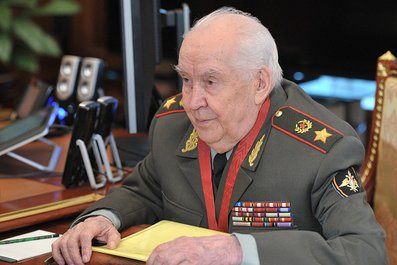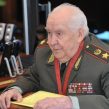
The Kremlin, the General Staff and Unlocking Future Warfare Capabilities
Publication: Eurasia Daily Monitor Volume: 11 Issue: 84
By:

As the Kremlin continues to spin the causes of conflict in Ukraine, highlighting the Crimean annexation primarily for domestic political consumption, Russian military theorists are considering how the operation in Crimea may influence the evolution of military thinking. In the context of an unprecedented military modernization program to 2020, the ongoing discussion concerning force structure and manpower, as well as while military theorists wrestle with the changing nature of modern warfare itself, Moscow has every reason to re-examine its views on these issues (Interfax, May 5).
It is precisely this thinking that features in a recent article in Voyenno Promyshlennyy Kuryer by Army-General (retired) Makhmut Gareev, the president of the Academy of Military Sciences and widely regarded as Russia’s foremost military theorist. While Gareev has an unrivalled reputation in military thought, he also has a well-deserved reputation as a conservative who constantly frames his discussions on future warfare in terms of his key frame of reference: namely, the Great Patriotic War (World War II). In his article, unsurprisingly, Gareev’s starting point was to remind his readers that this year marks the 69th anniversary of the end of that conflict and the hundredth anniversary of the start of World War I. Turning to the operation in Crimea in February and March 2014, Gareev praises the “bloodless annexation” and highlights these events as a “new phenomenon” in national security. “Suddenly,” in Gareev’s opinion, Russia “showed the World” that “well-armed, trained, equipped and disciplined soldiers of the 21st century” can efficiently resolve their tasks; for Gareev it may mean a “new era” in the field of defense (https://www.vpk-news.ru/articles/20113).
The Russian political-military leadership will take great pride in Gareev’s comments. He argues that such pride is justified, but it must be accompanied by drawing appropriate lessons for Russia’s use of “soft power,” political, diplomatic and information resources, as well as for the “entire system of strategic deterrence.” Gareev concludes that “shortcomings” and “mistakes” may be overlooked by a victor in any conflict and urges the leadership in Moscow to meticulously examine the lessons that may be drawn from the recent operation in Crimea (https://www.vpk-news.ru/articles/20113).
If, as the Russian political-military leadership pursues defense modernization, some attention is devoted to the potential lessons from Crimea, the question is what could be unearthed, and how might this impact on the future of the Russian military? There is no short supply of Russian military theory on the future evolution of modern warfare, and there were certainly efforts to include features of this in reform and modernization plans following the Russia-Georgia War in August 2008. This work includes Russian thinking on unmanned aerial vehicle (UAV) strike systems, the use of robotics and nanotechnologies in future conflicts and, in essence, achieving pre-nuclear deterrence capabilities by developing network-centric warfare capabilities (see EDM, January 25, 2012).
Clear evidence exists that Moscow has genuine interest in such high-technology conventional warfare capabilities. Equally, there is abundant evidence that deep seated problems exist linked to the organizational and capacity weaknesses of the domestic defense industry. For instance at the center of introducing Command, Control, Communications, Computers, Intelligence, Surveillance and Reconnaissance (C4ISR) capabilities into the Russian military is the whole question of designing and sustaining the technology for automated command and control, and extending this to include communications as well as training the end users. Despite the Ukraine crisis and Western countries adopting sanctions against Russia, including a ban on high-tech exports, RIA Novosti reports that France continues to cooperate on supplying Mistral-type helicopter carriers for the Russian Navy and that Paris has not ruled out equipping them with the highly advanced SENIT-9 combat information–command and control system. Sources in the United Shipbuilding Corporation also denied reports that Paris intends to back away from the Mistral deal. The same source stated that the construction of the ships is proceeding on schedule in Vladivostok and Sevastopol, and will arrive in the Russian Navy in 2014–2015. A representative of Rosoboronpostavka (the Federal Agency for the Supply of Armaments, Military and Special Equipment and Material Resources) confirmed that the state procurement portal has published a tender for the acquisition of the Sigma-E combat information–command and control systems, worth more than 24 million rubles ($676,000), for the assault landing ship in Sevastopol (RIA Novosti, April 30).
Whether, in fact, Moscow can secure access to such products remains open to question, but the interest in refitting the military with much more advanced systems is still high. This is also the case within the domestic market. The Stavropol Signal radio enterprise (part of Kontsern Radioelektronyye Tekhnologii, KRET—Radio Technologies Concern) will soon deliver the first Gimalay electronic warfare radar stations for the fifth-generation T-50 fighter. Although the leadership of the Russian Air Force is frustrated by delays to introducing such advanced assets into its inventory, there are also other high-tech priorities for enhancing future airpower. Russian Air Force commander-in-chief Lieutenant-General Viktor Bondarev wants to make advances on UAVs currently employed for reconnaissance and targeting. Attack drones weighing more than a ton and armed with rockets and bombs are under development with companies such as Transas, Sokol, and Sukhoy. Bondarev sees the need to have UAVs fulfil strategic attack objectives (RIA Novosti, April 23).
Interest in modernization also extends into force structure. On April 24, Defense Minister Sergei Shoigu announced that army aviation brigades and helicopter regiments have begun to be activated in the Air Force structure. “The process of increasing its [army aviation’s] order of battle is under way now, and army aviation brigades, which previously had not been in the Air Force structure, as well as separate helicopter regiments are being activated,” Shoigu said. He noted that new and modernized models of aviation equipment such as Ka-52, Mi-28N, Mi-35M, and Mi-8AMTSh helicopters are arriving in the military (Interfax, April 24).
These interests in high-technology assets and further adjustments to force structure, of course, pre-date the Crimea operation. What Gareev’s call for lessons learned may highlight is the use of smaller elite rapid reaction forces as part of a wider campaign to achieve strategic objectives. In this sense, the first step may be finally abandoning the “one million” notional force strength and redesigning both the size and shape of the Russian Armed Forces to suit the country’s real security needs. But the Crimea operation, as successful as it was, did not offer any combat testing. Whatever these lessons might prove to be, Russian politicians will need to learn them just like the top brass in order to maximize any potential dividend from the Crimea operation.




